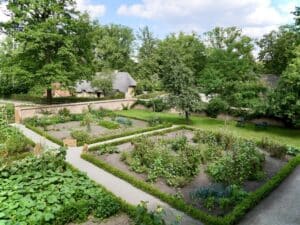Grow and Care for Bare Root Trees

Bare root trees are ready grown plants which have been uprooted from the field where they were grown, no soil remains on roots – hence the name, ‘bare rooted’.
Bare rooting can only be done with deciduous trees & shrubs while they are dormant. They are often cheaper as you are not paying for the pot, potting mix & transport of large bulky potted plants. They are often more advanced in their growth, and come in a wider variety of species too!
Quick Tips
- When planting, dig a hole about wider and 10-20cm cm wider for a 30cm pot. Mound some soil in the middle and spread the roots over the mound evenly.
- Don’t plant the tree too deep. Do not dig into clay, rather build up the site with topsoil. See our planting guide.
- Depending on the tree, you will need to prune significantly so that the tree can establish itself more quickly.
Storage
If you cannot plant your tree straight away, it is vital to keep the roots moist. You can store your tree in a bag with damp saw-dust for up to a week. You can also place your tree into a pot temporarily, or bury it in a shallow hole, just ensure the roots are kept moist. If you are storing your plant for 1 day, you may keep it in a bucket of water.
Preparation
You want the best possible soil ready to go for your bare-rooted tree. Once you get your bare rooted plant home, it is essential to act quickly, even though it is dormant there is still a risk of root damage. To prepare your soil, add some organic material & manure and mix it together with soil and water.
Planting
When planting your bare-rooted tree, dig a hole that is wider than it is deep, depending on the soil we generally recommend 10-20cm wider than the pot. If you have poor soil you may need to go as large as 1 meter wide. Place the roots on top of a mound soil in the middle of the hole. It should be high enough that the base of the tree sits at ground level.
Spread the roots over the mound evenly. Fill in the hole gently, wiggle the tree slightly as you go to help the roots make good contact with the soil. To finish, water in well. If the tree is in an exposed area, you may need to stake the tree as well.
Pruning
Pruning is an essential step to the success of your bare-rooted tree. When a tree is removed from the field, it loses a significant portion of its root system. If you don’t prune it back, the tree will have an unbalanced root to tree ratio, which will cause problems. Depending on the tree, you will need to prune significantly so that the tree can establish itself more quickly.
-
 13, Jun, 2025
13, Jun, 2025How to Start a Garden Design Project: Step-by-Step Planning Guide for Beginners
At Diaco’s, we know that creating a beautiful garden starts... -
 27, May, 2025
27, May, 2025Smart Garden Layout Ideas: How to Maximise Your Outdoor Space
At Diaco’s, we believe every garden has potential. Whether you’ve... -
 9, May, 2025
9, May, 20257 Garden Design Principles to Transform Your Outdoor Space
At Diaco’s, we know that creating a garden isn’t just...


